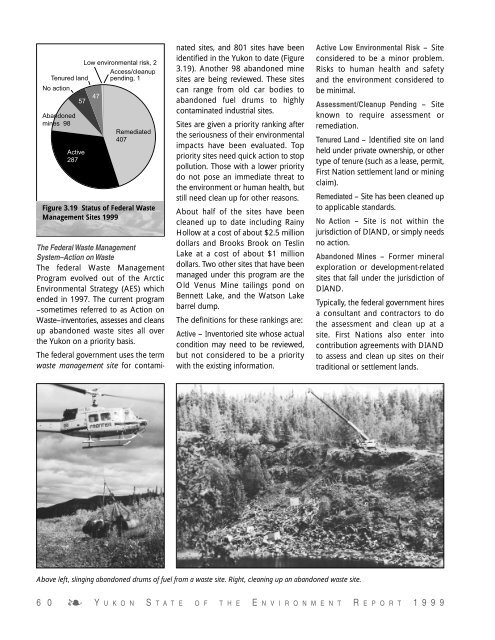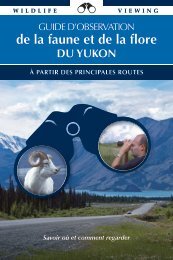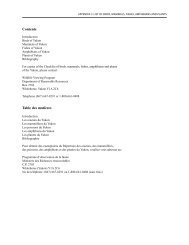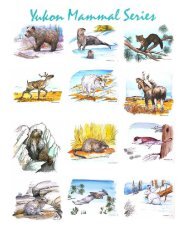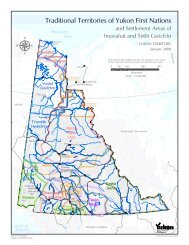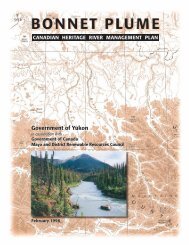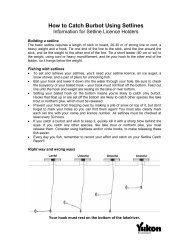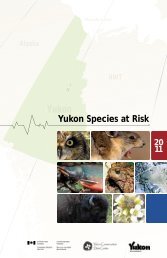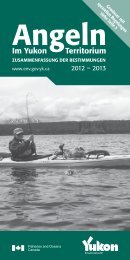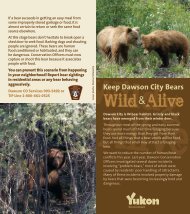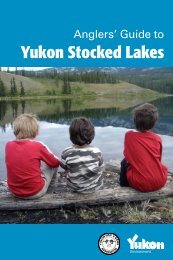Ch. 3 Land - Environment Yukon
Ch. 3 Land - Environment Yukon
Ch. 3 Land - Environment Yukon
Create successful ePaper yourself
Turn your PDF publications into a flip-book with our unique Google optimized e-Paper software.
Low environmental risk, 2<br />
Access/cleanup<br />
Tenured land pending, 1<br />
No action<br />
Abandoned<br />
mines 98<br />
Active<br />
287<br />
57 47<br />
Remediated<br />
407<br />
Figure 3.19 Status of Federal Waste<br />
Management Sites 1999<br />
The Federal Waste Management<br />
System–Action on Waste<br />
The federal Waste Management<br />
Program evolved out of the Arctic<br />
<strong>Environment</strong>al Strategy (AES) which<br />
ended in 1997. The current program<br />
–sometimes referred to as Action on<br />
Waste–inventories, assesses and cleans<br />
up abandoned waste sites all over<br />
the <strong>Yukon</strong> on a priority basis.<br />
The federal government uses the term<br />
waste management site for contami-<br />
nated sites, and 801 sites have been<br />
identified in the <strong>Yukon</strong> to date (Figure<br />
3.19). Another 98 abandoned mine<br />
sites are being reviewed. These sites<br />
can range from old car bodies to<br />
abandoned fuel drums to highly<br />
contaminated industrial sites.<br />
Sites are given a priority ranking after<br />
the seriousness of their environmental<br />
impacts have been evaluated. Top<br />
priority sites need quick action to stop<br />
pollution. Those with a lower priority<br />
do not pose an immediate threat to<br />
the environment or human health, but<br />
still need clean up for other reasons.<br />
About half of the sites have been<br />
cleaned up to date including Rainy<br />
Hollow at a cost of about $2.5 million<br />
dollars and Brooks Brook on Teslin<br />
Lake at a cost of about $1 million<br />
dollars. Two other sites that have been<br />
managed under this program are the<br />
Old Venus Mine tailings pond on<br />
Bennett Lake, and the Watson Lake<br />
barrel dump.<br />
The definitions for these rankings are:<br />
Active – Inventoried site whose actual<br />
condition may need to be reviewed,<br />
but not considered to be a priority<br />
with the existing information.<br />
Above left, slinging abandoned drums of fuel from a waste site. Right, cleaning up an abandoned waste site.<br />
Active Low <strong>Environment</strong>al Risk – Site<br />
considered to be a minor problem.<br />
Risks to human health and safety<br />
and the environment considered to<br />
be minimal.<br />
Assessment/Cleanup Pending – Site<br />
known to require assessment or<br />
remediation.<br />
Tenured <strong>Land</strong> – Identified site on land<br />
held under private ownership, or other<br />
type of tenure (such as a lease, permit,<br />
First Nation settlement land or mining<br />
claim).<br />
Remediated – Site has been cleaned up<br />
to applicable standards.<br />
No Action – Site is not within the<br />
jurisdiction of DIAND, or simply needs<br />
no action.<br />
Abandoned Mines – Former mineral<br />
exploration or development-related<br />
sites that fall under the jurisdiction of<br />
DIAND.<br />
Typically, the federal government hires<br />
a consultant and contractors to do<br />
the assessment and clean up at a<br />
site. First Nations also enter into<br />
contribution agreements with DIAND<br />
to assess and clean up sites on their<br />
traditional or settlement lands.<br />
6 0 ❧ Y U K O N S T A T E O F T H E E N V I R O N M E N T R E P O R T 1999


